Ozito PXCPRS-018U Handleiding
Ozito
Zaagmachine
PXCPRS-018U
Bekijk gratis de handleiding van Ozito PXCPRS-018U (3 pagina’s), behorend tot de categorie Zaagmachine. Deze gids werd als nuttig beoordeeld door 67 mensen en kreeg gemiddeld 5.0 sterren uit 34 reviews. Heb je een vraag over Ozito PXCPRS-018U of wil je andere gebruikers van dit product iets vragen? Stel een vraag
Pagina 1/3

PRS-012
MAINTENANCE
DESCRIPTION OF SYMBOLS
TROUBLESHOOTING
1. When not in use, the tool should be stored in a dry, frost free location, keep
out of children’s reach.
2. Keep ventilation slots of the saw clean at all times and prevent anything from
entering.
3. If the housing of the saw requires cleaning, do not use solvents. Use of a cloth
only is recommended.
4. Blow out the ventilation slots with compressed air periodically.
5. The blade can be sprayed with light oil to avoid rusting.
Note: Ozito Industries will not be responsible for any damage or injuries caused by
repair of the pruning saw by an unauthorised person or by mishandling.
WARRANTY
SPARE PARTS
PRUNING SAW SAFETY WARNINGS
GENERAL POWER TOOL SAFETY WARNINGS
ELECTRICAL SAFETY
0217
BATTERY AND CHARGER SAFETY WARNINGS
THIS MANUAL CONTAINS IMPORTANT SAFETY AND OPERATING INSTRUCTIONS FOR YOUR
BATTERY CHARGER.
1. Before using the charger read all instructions and cautionary markings on the charger, battery pack and the product
using the battery pack.
2. This charger is not intended for any uses other than charging rechargeable batteries. Any other use may result in risk
of re, electric shock or electrocution.
3. Do not place any object on top of the charger or place the charger on a soft surface that may result in excessive
internal heat. Place the charger in a position away from any heat source.
4. To reduce risk of damage to the electric plug and cord, pull by the plug rather than the cord when disconnecting the
charger.
5. Make sure the cord is located so that it will not be stepped on, tripped over, or otherwise subjected to damage or
stress.
6. An extension cord should not be used unless absolutely necessary. Use of an improper extension cord could result in the risk
of re, electric shock or electrocution.
7. Do not operate the charger if it has received a sharp blow, been dropped or otherwise damaged in any way. Have it
checked by an electrician or power tool repairer.
8. Do not disassemble charger. Take it to an electrician or power tool repairer when service or repair is required. Incor-
rect reassembly may result in a risk of electric shock, electrocution or re.
9. To reduce risk of electric shock, unplug the charger from the outlet before attempting any cleaning. Removing the
battery pack will not reduce this risk.
10. Never attempt to connect 2 chargers together.
11. DO NOT store or use the tool and battery pack in locations where the temperature may reach or exceed 40ºC (such as inside
sheds or metal buildings in summer).
12. The charger is designed to operate on standard household electrical power (240 volts). Do not attempt to use it on
any other voltage!
13. The battery pack is not fully charged out of the carton. First read the safety instructions and then follow the charging
notes and procedures.
14. The longest life and best performance can be obtained if the battery pack is charged when the air temperature is
between 18 - 24ºC. Do not charge the battery pack in an air temperature below 10ºC or above 40ºC. This is important
and will prevent damage to the battery pack.
15. Do not incinerate the battery pack even if it is seriously damaged or is completely worn out. The battery can explode in
a re.
16. Never attempt to open the battery pack for any reason. If the plastic housing of the battery pack breaks or cracks, immedi-
ately discontinue use and do not recharge.
17. During charging, the battery must be placed in a well ventilated area.
Warning Read instruction manual
Diameter
mA Milliamperes
Double insulated
/min Revolutions or reciprocation per minute
Ah Amp hour
Indoor use only
Nm o Newton Meters nNo load speed
VVolts Hz Hertz
ac/~ W Alternating current Watts
Direct current
dc/
Wear safety glovesKeep Bystanders away
Wear hearing protection
Do not expose to rainWear respiratory protection
Wear eye protection
Ø
LED lights do not illuminate on charger
Check the charging adaptor is securely plugged into the wall outlet.
Check the battery is rmly connected to the charging cradle.
Variable speed trigger is locked
Ensure that the safety switch is pressed left or right to enable the trigger to be pressed.
The blade will not insert or remove from the blade
holder
Ensure the blade holder is rotated completely clockwise before trying to insert or remove
the blade.
Saw has cut out during use
The battery may have run out of power and requires charging. If the battery is fully
charged, it is likely that the battery’s thermal voltage protection has been activated. This
can happen when the saw has been used for extended periods.
Place the battery on the charger for an hour. It will need this time to cool down and for the
protection circuits to be reset.
Saw suddenly speeds up
This is normal. Once the saw has started the cut into the timber, based on load, the blade
will speed up to complete the cut.
Sparking visible through the housing air vents
A small amount of sparking may be visible through the housing vents. This is normal and
does not indicate a problem.
WARNING! Read all safety warnings and all instructions. Failure to follow the warnings and
instructions may result in electric shock, re and/or serious injury.
Save all warnings and instructions for future reference. The term “power tool” in the
warnings refers to your mains-operated (corded) power tool or battery-operated (cordless)
power tool.
1. Work area safety
a. Keep work area clean and well lit. Cluttered or dark areas invite accidents.
b. Do not operate power tools in explosive atmospheres, such as in the presence of
flammable liquids, gases or dust. Power tools create sparks which may ignite the dust or fumes.
c. Keep children and bystanders away while operating a power tool. Distractions can cause you to lose
control.
2. Electrical safety
a. Power tool plugs must match the outlet. Never modify the plug in any way.
Do not use any adapter plugs with earthed (grounded) power tools. Unmodied plugs and matching
outlets will reduce risk of electric shock.
b. Avoid body contact with earthed or grounded surfaces, such as pipes, radiators, ranges
and refrigerators. There is an increased risk of electric shock if your body is earthed or grounded.
c. Do not expose power tools to rain or wet conditions. Water entering a power tool will increase the risk of
electric shock.
d. Do not abuse the cord. Never use the cord for carrying, pulling or unplugging the power
tool. Keep cord away from heat, oil, sharp edges or moving parts. Damaged or entangled cords
increase the risk of electric shock.
e. When operating a power tool outdoors, use an extension cord suitable for outdoor use. Use
of a cord suitable for outdoor use reduces the risk of electric shock.
f. If operating a power tool in a damp location is unavoidable, use a residual current device
(RCD) protected supply. Use of an RCD reduces the risk of electric shock.
3. Personal safety
a. Stay alert, watch what you are doing and use common sense when operating a power
tool. Do not use a power tool while you are tired or under the influence of drugs, alcohol
or medication. A moment of inattention while operating power tools may result in serious personal injury.
b. Use personal protective equipment. Always wear eye protection. Protective equipment such as dust
mask, non-skid safety shoes, hard hat, or hearing protection used for appropriate conditions will reduce personal injuries.
c. Prevent unintentional starting. Ensure the switch is in the off-position before connecting
to power source and/or battery pack, picking up or carrying the tool. Carrying power tools with
your nger on the switch or energising power tools that have the switch on invites accidents.
d. Remove any adjusting key or wrench before turning the power tool on. A wrench or a key left
attached to a rotating part of the power tool may result in personal injury.
e. Do not overreach. Keep proper footing and balance at all times. This enables better control of the
power tool in unexpected situations.
f. Dress properly. Do not wear loose clothing or jewellery. Keep your hair, clothing and
gloves away from moving parts. Loose clothes, jewellery or long hair can be caught in moving parts.
g. If devices are provided for the connection of dust extraction and collection facilities,
ensure these are connected and properly used. Use of dust collection can reduce dust-related hazards.
4. Power tool use and care
a. Do not force the power tool. Use the correct power tool for your application. The correct power
tool will do the job better and safer at the rate for which it was designed.
b. Do not use the power tool if the switch does not turn it on and off. Any power tool that cannot be
controlled with the switch is dangerous and must be repaired.
c. Disconnect the plug from the power source and/or the battery pack from the power tool
before making any adjustments, changing accessories, or storing power tools. Such preventive
safety measures reduce the risk of starting the power tool accidentally.
d. Store idle power tools out of the reach of children and do not allow persons unfamiliar
with the power tool or these instructions to operate the power tool. Power tools are dangerous in
the hands of untrained users.
e. Maintain power tools. Check for misalignment or binding of moving parts, breakage of
parts and any other condition that may affect the power tool’s operation. If damaged,
have the power tool repaired before use. Many accidents are caused by poorly maintained power tools.
f. Keep cutting tools sharp and clean. Properly maintained cutting tools with sharp cutting edges are less likely to
bind and are easier to control.
g. Use the power tool, accessories and tool bits etc. in accordance with these instructions,
taking into account the working conditions and the work to be performed. Use of the power tool
for operations different from those intended could result in a hazardous situation.
5. Battery tool use and care
a. Recharge only with the charger specified by the manufacturer. A charger that is suitable for one
type of battery pack may create a risk of re when used with another battery pack.
b. Use of any other battery packs may Use power tools only with specifically designated battery packs.
create a risk of injury and re.
c. When battery pack is not in use, keep it away from other metal objects, like paper clips,
coins, keys, nails, screws or other small metal objects, that can make a connection from
one terminal to another. Shorting the battery terminals together may cause burns or a re.
d. Under abusive conditions, liquid may be ejected from the battery; avoid contact. If contact
accidentally occurs, flush with water. If liquid contacts eyes, additionally seek medical
help. Liquid ejected from the battery may cause irritation or burns.
6. Service
a. Have your power tool serviced by a qualified repair person using only identical replacement
parts. This will ensure that the safety of the power tool is maintained.
b. If the supply cord is damaged, it must be replaced by the manufacturer, its service agent or
similarly qualied persons in order to avoid a hazard.
This appliance is not intended for use by persons (including children) with reduced physical, sensory
or mental capabilities, or lack of experience and knowledge, unless they have been given supervision or instruction
concerning use of the appliance by a person responsible for their safety.
Young children should be supervised to ensure that they do not play with the appliance.
• Keep all parts of the body away from the saw blade when the saw is operating. Before
you start the pruning saw, make sure the saw blade is not contacting anything. A moment of
inattention while operating saws may cause entanglement of your clothing or body with the saw blade.
• Wear safety glasses and hearing protection. Further protective equipment for head,
hands, legs and feet is recommended. Adequate protective clothing will reduce personal injury by ying debris
or accidental contact with the saw blade.
• Do not operate a pruning saw in a tree. Operation of a pruning saw while up in a tree may result in personal
injury.
• Always keep proper footing and operate the pruning saw only when standing on fixed,
secure and level surface. Slippery or unstable surfaces such as ladders may cause a loss of balance or control of the
saw.
• When cutting a limb that is under tension be alert for spring back. When the tension in the wood
bres is released the spring loaded limb may strike the operator and/or throw the pruning saw out of control.
• Useextremecautionwhencuttingbrushandsaplings. The slender material may catch the saw blade and
be whipped toward you or pull you off balance.
• Keephandlesdry,clean,andfreefromoilandgrease. Greasy, oily handles are slippery causing loss of
control.
• Do not touch the blade or the work piece immediately after operation; they may be extremely hot
and could potentially burn your skin.
• If you withdraw the blade from the work piece during operation, a strong reaction could
be produced, which could cause the blade to snap or cause you to lose your grip and/or control of the saw. Always switch
off the tool and wait until the blade has come to a complete stop before with drawing the blade from the work piece.
• Maintainarmgrip,withthumbsandngersencirclingthepruningsawhandles,withbothhandsonthesawandpositionyour
body and arm to allow you to resist kickback forces. Kickback forces can be controlled by the operator, if proper precautions are
taken. Do not let go of the pruning saw.
• Donotoverreachanddonotcutaboveshoulderheight.Thishelpspreventunintendedtipcontactandenablesbettercontrolof
the pruning saw in unexpected situations.
• Onlyusereplacementbladesspeciedbythemanufacturer.Incorrectbladesmaycausebladebreakageand/orkickback.
SPECIFICATIONS
Input: 18V
Stroke Length: 20mm
Stroke Speed: 1500-2800/min
Max. Cutting Diameter: 70mm (with clamping jaw)
90mm (w/o clamping jaw)
Weight: 1.2kg
WHAT’S IN THE BOX
Cordless Pruning Saw
Battery & Charger sold separately
CORDLESS
PRUNING SAW
ORIGINAL INSTRUCTIONS
ozito-diy.co.uk
PXCPRS-018U
1 x Saw Blade
WARNING!: BEFORE CLEANING YOUR PRUNER OR
CARRYING OUT ANY MAINTENANCE PROCEDURE,
MAKE SURE THAT THE MOTOR IS OFF AND THE
BATTERY REMOVED TO PREVENT ACCIDENTAL STARTING.
OZITO UK Unit 9 Stadium Court, Wirral International Business Park, Plantation Road, Bromborough, Wirral, CH62 3QG
All of our products undergo strict quality checks to ensure that they reach you in perfect
condition. In the unlikely event that your device develops a fault, please contact our service
department at the address shown on this guarantee card. You can also contact us by
telephone using the customer service number shown. Please note the following terms under
which guarantee claims can be made:
1. These warranty terms regulate additional warranty services, which the manufacturer
mentioned below promises to buyers of its new products in addition to their statutory
guarantee claims are not affected by this guarantee. Our guarantee is free of charge to you.
2. The warranty services only covers defects due to material or manufacturing faults on
a product which you have bought from the manufacturer mentioned below are limited to
either the rectication of said defects on the product or the replacement of the product,
whichever we prefer.
Please note that our devices are not designed for use in commercial, trade or professional
applications. A guarantee contract will not be created if the device has been used by
commercial, trade or industrial business or has been exposed to similar stresses during the
guarantee period.
3. The following are not covered by our guarantee:
- Damage to the device caused by a failure to follow the assembly instructions or due to
incorrect installation, a failure to follow the operating instructions (for example connecting
it to an incorrect mains voltage or current type) or a failure to follow the maintenance and
safety instructions or by exposing the device to abnormal environmental conditions or by
lack of care and maintenance.
- Damage to the device caused by abuse or incorrect use (for example overloading the
device or the use or unapproved tools or accessories), ingress of foreign bodies into the
device (such as sand, stones or dust, transport damage), the use of force or damage caused
by external forces (for example by dropping it).
- Damage to the device or parts of the device caused by normal or natural wear or tear or by
normal use of the device.
4. Your Product is guaranteed for a period of 60 months from the original date of purchase
and is intended for DIY (Do It Yourself) use only. Lithium Ion batteries and chargers are
covered by a 12 month warranty. Warranty excludes consumable parts. Guarantee claims
should be submitted before the end of the guarantee period within two weeks of the defect
being noticed. No guarantee claims will be accepted after the end of the guarantee period.
The original guarantee period remains applicable to the device even if repairs are carried
out or parts are replaced. In such cases, the work performed or parts tted will not result
in an extension of the guarantee period, and no new guarantee will become active for the
work performed or parts tted. This also applies if an on-site service is used.
IN ORDER TO MAKE A CLAIM UNDER THIS WARRANTY YOU MUST RETURN THE PRODUCT TO
THE PLACE OF PURCHASE WITH YOUR REGISTER RECEIPT.
Please refer to the restrictions of this warranty concerning wearing parts, consumables and
missing parts as set out in the service information in these operating instructions.
CUSTOMER SERVICE HELPLINE
GB: 0151 294 4488
IRL: 1850 882711
Ozito-diy.co.uk
Spare parts can be ordered from the Special Orders Desk at your local
Bunnings Warehouse or Homebase store.
For further information, or any parts visit
www.ozito-diy.co.uk or contact Ozito Customer Service:
Great Britain: 0151 294 4488
Ireland: 1850 882711
E-mail: info@ozito-diy.co.uk
WARNING! When using mains-powered tools, basic safety precautions, including
the following, should always be followed to reduce risk of fire, electric shock, personal
injury and material damage.
Read the whole manual carefully and make sure you know how to switch the tool off in an emergency, before operating the tool.
Save these instructions and other documents supplied with this tool for future reference.
Before you connect the charger to the mains supply make sure that the data on the rating plate are identical to the mains data.
This tools charger is double insulated therefore no earth wire is required.
Note: Double insulation does not take the place of normal safety precautions when operating this tool. The insulation system is for
added protection against injury resulting from a possible electrical insulation failure within the tool.
The power supply for this products charger should be protected by a residual current device (rated at 30mAor less). A residual current
device reduces the risk of electric shock.

ONLINE
MANUAL
Scan this QR Code with your mobile
device to take you to the online
manual.
KNOW YOUR PRODUCT SETUP & PREPARATION
1. BATTERY & CHARGER (SOLD SEPARATELY) 2. CUTTING BLADES 3. PREPARATION 4. CONTROLS AND OPERATION
1. Blade Holder
2. Locking Sleeve
3. Blade
4. Clamping Jaw
5. Clamp Lever
6. Protective Cover
7. Safety Switch
8. Variable Speed Trigger
9. Main Handle
10. Battery Seating
CORDLESS PRUNING SAW
OPERATION
1 2
3 4 9 105 6 7 8
WARNING! ENSURE THE BATTERY IS DISCONNECTED
FROM THE TOOL BEFORE PERFORMING ANY OF THE
FOLLOWING OPERATIONS.
CAUTION! DO NOT HANDLE BLADES WITHOUT GLOVES
AS THEY ARE SHARP AND CAN BECOME HOT AFTER
USE, POTENTIALLY CAUSING PERSONAL INjURY.
3. Insert the cutting blade into the blade holder then release the blade holder
3. Remove the cutting blade from
the blade holder.
3.
2. Rotate and hold the blade
holder as shown.
2. Rotate and hold the blade
holder as shown.
4. Ensure the blade is
secure by pulling on the
blade.
The pruning saw can be tted with standard reciprocating saw blades, therefore can be
used to cut various timbers and plastics.
Fitting a Cutting Blade
Removing the Cutting Blade
Switching the Saw On and Off
Cutting Branches Using the Clamping jaw
Cutting Without the Clamping jaw
2. Release the variable speed trigger to
stop the pruning saw.
2. Place the branch in
between the clamping
jaws and then lower to
perform the cut.
Note: The clamping jaw
helps to guide the saw when
cutting round branches up to
Ø70mm.
1. Push the safety switch
in from either side of the
tool and then squeeze the
variable speed trigger to
start the pruning saw.
1. Ensure the blade and the clamping jaw is secured correctly and hold the saw rmly.
1. Position the bracket
rail of the saw onto the
material to be cut for
stability and then perform
the cut holding the saw
rmly.
When cutting thicker branches (up to Ø90mm) or sawing wood or plastic the clamping
jaws can be removed to prevent them getting in the way of the cut.
BATTERY & CHARGER
(sold separately)
This tool is compatible with all battery and
chargers from the Ozito Power X Change Range.
CAUTION: THE CHARGER FOR THIS PRODUCT
SHOULD BE PROTECTED BY A RESIDUAL CURRENT
DEVICE (RATED AT 30mA OR LESS).
The purchased battery will be shipped in a low charge condition, and requires charging
prior to use. Allow several cycles of charging and discharging (through use of the tool)
for the battery to reach its optimum performance / runtime.
1. Connect the charger into a mains power outlet.
4. The charger LED will illuminate
red signifying that the battery is
charging.
3. With the charger sitting on a at
surface, align the raised ribs on
the battery with the recess in the
charger and slide onto the charger
ensuring a rm connection.
2. The charger LED will ash green
showing power is being supplied
to the charger.
5. The charger LED will illuminate
green once the battery is charged.
Charging your lithium ion battery - Fast Charger
Charger LED Indicator
LED Indicator Situation
GREEN (Flashing) Stand By (no battery pack is inserted)
RED (Flashing) Battery is charging (low charge)
RED (Illuminated) Battery is charging (mid charge)
GREEN (Illuminated) Battery is 85% - 100% charged and ready for use.
BOTH(Illuminated) Battery pack is too hot or too cold (charging will begin
automatically when battery reaches correct charging
temperature).
BOTH (Flashing) Defective battery. Never charge a defective battery
pack!
Remove battery pack from charger.
Battery Charge Indicator
The purchased battery is equipped with a
battery charge indicator to show the state of
the battery charge.
Press the charge indicator button and look to
see which LED lights.
Battery requires
immediate charging
Low state of charge, requires charging soon.
Mid state of charge
Full state of charge.
Note: The battery needs to be removed from the tool to check the state of charge.
1. Connect the charger into a mains power outlet.
4. The charger LED will illuminate red signifying that the battery is charging.
3. With the battery sitting on a at
surface, align the raised ribs on the
battery with the recess in the charger
and slide onto the battery ensuring a
rm connection.
2. The charger LED will ash green
showing power is being supplied
to the charger.
5. When removing the charger from the
battery, rst press the battery release
tab, then slide the charger from its
position.
Charging your lithium ion battery - Eco Charger
Charger LED Indicator
LED Indicator Situation
GREEN (Flashing) Stand By (no battery pack is inserted)
RED (Illuminated) Battery is charging (low charge)
GREEN (Illuminated) Battery is charged and ready for use.
RED (Flashing) Battery or Charger fault
RED & GREEN (Flashing) Battery pack is too hot or too cold (remove battery from
charger and store at room temperature 20ºC. Insert
battery again when at correct charging temperature). If
this happens again, the battery is defective and needs
to be replaced.
1. Press both sides of the
protective cover and open
it.
5. Close the protective cover
1. Open the protective cover.
4. Close the protective cover
PXCPRS-018U
The clamping jaw allows branches to be gripped up to Ø60mm, providing cutting of
unsupported branches easier. When cutting wider branches or timber, the clamping jaw
can be removed and the pruning saw can be used as a standard reciprocating saw.
Removing the Clamping jaw
1. Press the clamp lever and
pull the bracket from the
bracket rail.
Clamp
Lever
Bracket
Rail
Fitting the Clamping jaw
1. First align the clamping
jaw with the bracket rail,
then slide it onto the rail
while pressing the clamp
lever.
2. Release the clamp lever
to lock in place.
Note: Ensure the clamp
jaw is secured by pulling
the clamp jaw away from
the body.
3.
Installing and Removing the Batttery
1. Slide the battery in so
that it clicks into place.
2. To remove, press and hold the
battery release tab to release the
battery, then slide the battery out..
When the variable speed trigger is fully depressed and the saw has started the cut into
the timber, based on load, the blade will speed up to complete the cut.
Torque Control Trigger
Product specificaties
| Merk: | Ozito |
| Categorie: | Zaagmachine |
| Model: | PXCPRS-018U |
Heb je hulp nodig?
Als je hulp nodig hebt met Ozito PXCPRS-018U stel dan hieronder een vraag en andere gebruikers zullen je antwoorden
Handleiding Zaagmachine Ozito

24 December 2024

23 Augustus 2024

23 Augustus 2024

23 Augustus 2024

30 Juli 2024

30 Juli 2024

9 Juli 2023

26 Juni 2023

24 Juni 2023

20 Juni 2023
Handleiding Zaagmachine
- Varo
- Hecht
- Turbo-Silent
- Topcraft
- TAURUS Titanium
- EFA
- Dream Power
- Cobra
- Dexter
- Snow Joe
- Fuxtec
- Extralink
- Ryobi
- Porter-Cable
- Gude Pro
Nieuwste handleidingen voor Zaagmachine
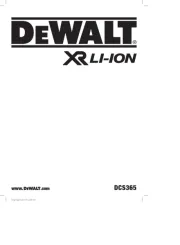
3 Augustus 2025
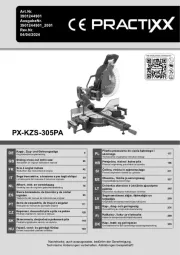
30 Juli 2025
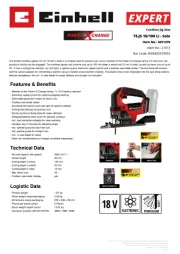
29 Juli 2025
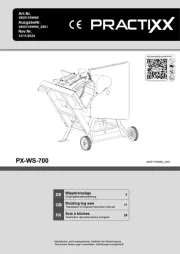
29 Juli 2025
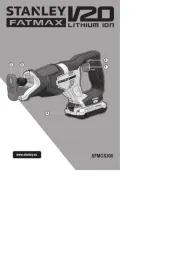
29 Juli 2025
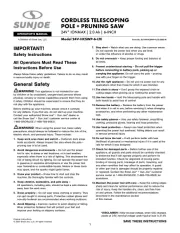
29 Juli 2025
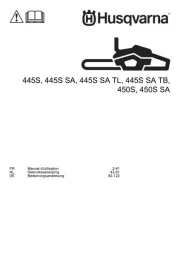
28 Juli 2025
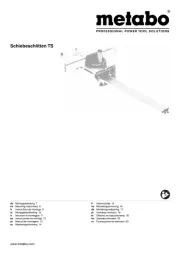
23 Juli 2025
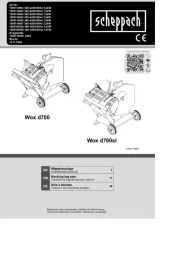
21 Juli 2025
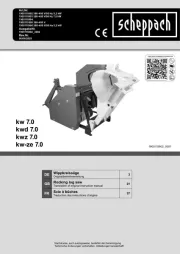
21 Juli 2025